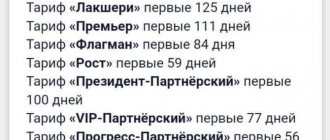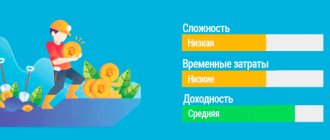The formula for compound interest on deposits reflects the operation when the profit received from the deposit is added to the principal amount. In the future, this money, after capitalization, will serve as the basis for accrual. Reinvesting the income received is characterized by a number of advantages that allow the investor to manage the funds rationally.
The concept of compound interest
Why do investors claim that it is possible to create capital even with small amounts? By putting 5,000 rubles a month into an account, will you really save anything significant?
Firstly, depending on what you mean by essential. Some people want to buy an apartment, others want to buy a bicycle, others create passive income for retirement. Secondly, you can actually create capital with small amounts. Investors don't lie because they are already well acquainted with the magic of compound interest.
In the article I will definitely show how this works with numbers and specific examples. In the meantime, let's remember our childhood. In winter, many of us made a snowman. They took a small lump of snow, rolled it, and it grew into a big lump. The same thing happens with our money, which we do not put in the nightstand, but make it work for us. Compound interest helps with this.
Compound interest is a percentage that is calculated from the original amount, then added to it, then calculated from the new amount, taking into account previously accrued income, and so on until the end of the billing period. In the banking industry, this process is called capitalization.
In the 1st year, a small amount grows with a small income. In the 2nd year, income will be accrued to “Amount + Income for the 1st year”, in the 3rd year – “Amount + Income for the 1st and 2nd years”, etc. I will show you with a simple example. The figures are conditional, given for ease of understanding the process, and have nothing to do with real deposits.
You deposited 10,000 rubles into your account at 10% per annum. A year later, 11,000 rubles were withdrawn. Now let’s say that they didn’t withdraw it, but left it on the account at the same 10% per annum. Only already 11,000 ₽. After a year, the bank charges another 10% on them. And now you see 12,100 ₽ on your account. Looking ahead, I will say that in 10 years it will be 25,937.42 rubles, and in 40 years – 452,592.56 rubles. Notice that you are not doing anything other than withdrawing money.
The numbers increase significantly if you regularly top up your account, but more on this is yet to come and will definitely use examples.
What is compound interest?
Compound interest is interest on a deposit or loan that takes into account both your original amount and the interest that amount has accumulated over previous periods. Because you earn interest not only on the principal each period but also on the accumulated amount, you get more return on your investment.
With compound interest, you add the interest you earn back to your principal balance, which then earns you even more interest, thereby increasing your profits.
Let's say you have $1,000 in a savings account that earns 5% interest. In the first year, you'll earn $50, giving you a total balance of $1,050. In the second year, you will earn 5% on the $1,050 balance, which is $52.50, giving you a new balance of $1,102.50 at the end of the second year.
Thanks to the magic of compound interest, your savings account balance's growth will accelerate over time as you earn interest on larger and larger balances. If you leave $1,000 in a savings account for 30 years, continue to earn 5% interest, and never add a penny to the account, you will end up with a balance of $4,321.94.
Interest can be increased or added back to the principal at different intervals. For example, interest may be compounded annually, monthly, daily, or even continuously. The more frequently interest is compounded, the faster your account balance grows.
If you started with a savings account balance of $1,000, but the interest you earned increased daily instead of annually, after 30 years you would have a total balance of $4,481.23. You'd earn an extra $160 by compounding interest more frequently.
Calculation formulas
Since there is a compound interest rate, it means there is also a simple interest rate. It's unfair if we don't deal with our hero's younger brother.
Simple interest
Simple interest is accrued every billing period (month, quarter, year) only on the initial amount. It does not give any “snowball” effect. The amount increases slowly.
Calculation formula:
SN = SP * (1 + % st * N), where
- SN – amount at the end of period N;
- SP – initial amount of capital;
- % st – interest rate (income);
- N – billing period.
The formula is valid if we are talking about accruing income once a year. For example, we deposited 100,000 rubles into an account at 10% per annum for 10 years. At the end of the term you will receive: 100,000 * (1 + 0.1 * 10) = 200,000 rubles.
More than 100 cool lessons, tests and exercises for brain development
Start developing
In real life, the concept of simple % is used, for example, in economic calculations for bank deposits without taking into account capitalization. The contract must indicate the annual interest rate. Interest is accrued for each day the money is on deposit. And the investor can receive income monthly, quarterly or once a year.
In this case, the formula will take the form:
SN = SP * (1 + % st * D / 365), where
- D – the number of full days the money is on deposit.
For example:
- We deposited 100,000 rubles into the account at 10% per annum for 91 days. At the end of the term you will receive: 100,000 * (1 + 0.1 * 91 / 365) = 102,493.15 rubles.
- For 180 days: 100,000 * (1 + 0.1 * 180 / 365) = 104,931.51 RUR.
- For 2 years (730 days): 100,000 * (1 + 0.1 * 730 / 365) = 120,000 ₽.
Compound interest with income accrued once a year
Using the compound interest method, when income is calculated once a year, the future amount is determined by the formula:
SN = SP * (1 + % st)N
Example. They deposited 100,000 rubles in the bank at 10% per annum for 2 years. The future value of the deposit will be: 100,000 * (1 + 0.1)2 = 121,000 rubles.
Compound interest with income accrued more than once a year
Income can be accrued monthly, quarterly or twice a year. The formula changes:
SN = SN * (1 + % st / K)N*K, where
- K – frequency of income accrual (12, 4 or 2 times a year).
Example. They deposited 100,000 rubles into the bank at 10% per annum for 2 years with monthly interest accrual. The future value of the deposit will be: 100,000 * (1 + 0.1/12)24 = 122,039.1 rubles.
02.05.2020
26 279
10 most profitable bank deposits today
Criteria for choosing a bank for a deposit and an overview of the best offers.
Afterword
As part of this review, you learned what interest capitalization is, what the formula for compound interest is, and also saw an example with a calculation demonstrating the difference in income.
While compound interest can be interesting, it is always important to remember to use common sense and use your own head. Firstly, there may be various subtleties (what and when you can withdraw, what happens if you withdraw money earlier, multiple periods, and so on).
Secondly, excessive complexity in calculations and comparisons, especially if fractional figures are used (for example, 6.03% per year with annual capitalization for 10 years will be approximately 79.6% of income, but 5.96% with monthly capitalization will be 81 .2%). Such things are not easy for the average person to notice.
Thirdly, capitalization provides for the automatic re-investment of money, while simple interest may imply the ability to use income for other purposes. And so on.
Key parameters influencing the calculation result
The amount that a depositor or investor will receive at the end of the settlement period depends on a number of key parameters:
- Interest rate is the return you receive from investing your funds in a particular instrument, or the fee for using “other people’s” money (for example, a loan). The higher the %, the more you will earn or pay.
- Settlement period – the period (days, months, years) during which it is planned to receive income or pay for loan funds. The higher it is, the greater the amount accumulated or paid to creditors.
- Starting capital is the amount that you initially allocated for savings or received on credit.
- Frequency of additional contributions. Over a short period of time, the effect of additional amounts deposited into the account is insignificant. The snowball begins to grow at a noticeable pace from the 5th–7th year of accumulation or repayment.
- The frequency of % accrual is daily, monthly, quarterly or annually. The more often, the higher the rate of increase in the amount.
It is not necessary to independently calculate the amounts using the above formulas and play with changing key parameters. There are numerous online calculators on the web, into which all you have to do is plug in the numbers. As a last resort, you can enter the formulas into Excel once and consider different calculation options. In further examples I will use an online calculator.
Things to remember
- Compound interest is a mathematical formula that triggers the snowball effect. Investments of money bring income, and then that gives new income. The longer this goes on, the more a person earns.
- It is useful to use compound interest on almost any investment, from a bank deposit to the purchase of shares.
- Compound interest can be calculated by hand, in a spreadsheet or on a calculator - it's not difficult, there are only five variables in the formula.
- The results of compound interest can only be predicted. Good performance in the past does not mean that a person will earn the same in the future.
Mechanism of operation
So far we have looked at how compound interest works in theory. Let's look at what they are in practice, using the example of bank deposits and investments.
Using the example of a bank deposit
When choosing a bank deposit, the depositor must pay attention to several parameters: the reliability of the bank, its participation in the state insurance system, conditions for replenishing and withdrawing money, the minimum amount in the account. But the main one is the interest rate and the conditions for its calculation.
The compound interest mechanism is connected to deposits with interest capitalization. And the rate itself, which will be valid on your account, is called effective. If you do not plan to withdraw accrued income during the entire accumulation period, then it is logical to choose a deposit with capitalization.
Let's compare the income received on the deposit with interest accrued annually, quarterly, monthly and daily. Initial conditions:
- amount – 400,000 ₽;
- % rate – 4% per annum;
- deposit term: 1, 2 and 3 years.
The amount that the investor will receive at the end of the term will be:
| Deposit term | Interest accrual | |||
| 1 time per year | 1 time per quarter | 1 time per month | 1 per day | |
| 1 year | 416 000 | 416 241,6 | 416 296,62 | 416 323,38 |
| 2 years | 432 640 | 433 142,68 | 433 257,18 | 433 312,9 |
| 3 years | 449 945,6 | 450 730,01 | 450 908,75 | 450 995,73 |
In investments
Compound interest works not only in banking, but also in the investment sector. If in banks the process of calculating interest on interest is called capitalization, then in investments it is called reinvestment, i.e. re-investment. But the essence remains the same.
Long-term investors are well aware of the compound interest mechanism and try to use it to the maximum. Let's look at how it works in various investment instruments.
- Bonds
The yield of a bond consists of two sources – growth in quotes and coupons. The latter are paid as a percentage of the face value of the security. As a rule, once every six months.
The effect of compound interest can be observed on coupon payments, but only in one case - if you do not spend the profit received on current consumption, but re-invest it in investments, i.e. reinvest. It is clear that the income from one bond can buy little. But if there are several dozen or hundreds of securities, then the amount is sufficient to purchase several more bonds.
Complete information about current strategies that have already brought millions of passive income to investors
For example, the owner of one OFZ-26212-PD will receive 35.15 rubles twice a year. In a year he will earn 70.3 rubles. You cannot buy a new OFZ with this money. If there is not one bond, but, for example, 50 pieces, then the income for the year will be 3,515 rubles. You can buy 3 more OFZs for RUB 1,085.81/piece. (quote as of October 27, 2020).
If you do not hold a bond until maturity, but are trying to make money on rising quotes, then in this case it is better to reinvest the profit received from resale to enable the compound interest mechanism.
- Stock
Exactly the same effect as described in the previous example can be achieved by reinvesting income from shares in the purchase of new shares. To do this, dividends received do not need to be withdrawn from the account, but reinvested.
Not all issuers pay dividends. Some investors buy growth stocks into their investment portfolios, i.e. securities that may increase in price in the future. Bought cheaper, sold more expensive is one of the investment strategies. Compound interest will be earned if the profit received from resale increases the capital in the investment, and not the number of items in the wardrobe.
The snowball mechanism works similarly with other investment instruments. The effect can be enhanced if you invest in an individual investment account, then each income tax refund (maximum 52,000 rubles per year) must be returned to the brokerage account again and securities purchased.
Compound interest in the stock market
As for how compound interest works in investing in the stock market, the principle remains the same, except that there is no concept of capitalization of interest. Instead, the trader manually reinvests the income received or selects investment instruments that provide reinvestment by default.
When working in this direction, the trader invests money in stocks and bonds. By combining different instruments, you can create a portfolio with an emphasis on increasing its value or stable regular income (analogous to a bank deposit).
There is no active trading when investing. An investment portfolio is compiled, then the trader only adjusts it, excluding securities that show a deterioration in profitability. Instead, the portfolio includes stocks that are in the growth stage.
Some companies pay dividends to the holders of their shares - distribute a certain part of the profit between them (dividend aristocrats do this even in unprofitable years). The investor can withdraw this money, or can reinvest it by purchasing additional shares with the money received, and thus using compound interest in investing.
Let's look at an example with an investment portfolio that copies the American S&P 500 index. It includes about 500 of the largest American companies, including those that pay dividends.
For convenience, we work with ETF SPY, this is the oldest ETF fund, operating since 1993 and has already attracted hundreds of billions of dollars for management. Excluding dividends, the return for the period from the beginning of 2010 to June 2022 was 176.71%. Starting $10,000 turned into $27,671.
For the same period, dividends were accrued in the amount of $3,783. The total income at this distance was 214.54% or $21,454.
When accrued dividends are reinvested, income increases at the same distance. The starting $10,000 grew to $34,161, a profit of 241.61%, which exceeds the previous figure.
The average annual return of the index without reinvestment of dividends is 11.37%, with reinvestment – 13.35%. The difference is not as obvious as in the example with a bank deposit, but investments at compound interest increase profitability here too.
At the same time, dividend payments are “spread out” over time and do not feel like a solid income. Their repeated investment will not hurt the investor's pocket, but will provide an advantage in the future.
The main disadvantage of dividends is the need to pay taxes; there are no legal methods to avoid paying them. Payments are credited to the brokerage account after taxes are paid, and to implement the compound interest scheme, the trader will have to independently purchase additional shares using them. Due to the payment of tax, the reinvested amount is slightly reduced, and additional commission costs arise.
It is more convenient to work through ETF funds , which provide for automatic reinvestment of dividends. Each ETF share corresponds to an entire portfolio of securities of companies included in the index, which the ETF replicates. In the same SPY example, all you need to do is buy a share of the fund to automatically invest in all S&P 500 stocks.
Mutual funds also do not pay tax on dividends when they are reinvested. But in mutual funds, compared to ETFs, the management fee is an order of magnitude higher.
Another option is investing in bonds and Eurobonds. This type of instrument provides a guaranteed coupon income, usually up to 7-10%, if we take into account only highly reliable issuers. The price of paper also changes, but in a narrow range compared to shares.
After the bond expires, the issuer redeems it by paying the holder an amount equal to the face value. Here, the implementation of this scheme involves spending coupon income on the purchase of new bonds. The number of securities in the portfolio increases, which increases its profitability in money. Thus, compound investment interest is used here.
Another option is not just to reinvest income, but at the same time to diversify risks, including new instruments in the investment portfolio. This increases its stability and profitability.
How to create passive income for retirement even with 1,000 rubles in your pocket
The retirement age has been increased, the funded pension has been frozen, pension reform is regularly carried out and conditions are changed. All these chaotic movements only indicate that the leadership does not have a clear action plan and vision of how pensions should be calculated in our country.
What conclusion should the ordinary citizen draw from all this? There is only one way - to save for retirement on your own. And compound interest will help with this. Using specific calculations, we’ll see how to create passive income even with 1,000 rubles a month. But first, a wonderful tale from Bodo Schaefer’s book “Mani, or the ABC of Money.”
Once upon a time there lived a peasant. Every morning he went to the chicken coop to take for breakfast the egg that his chicken had laid. But one day he found in the nest not an ordinary egg, but a golden one. At first he couldn't believe it. Perhaps someone decided to play a cruel joke on him. But the jeweler to whom he brought the egg to show it confirmed that it was made of pure gold. The peasant sold the egg at a profit and organized a big celebration.
The next morning he went to the chicken coop earlier than usual. There was a golden egg in the nest again. This went on for several days. But the peasant was greedy and wanted to get rich quickly. He was angry with his hen because the “stupid bird” could not explain to him how she managed to lay golden eggs. It seemed to him that then he could lay golden eggs himself. Then he would have two eggs every day. And one day the peasant got so angry that he ran into the chicken coop and killed his chicken. There was no one to lay the golden eggs.
The moral of the story is: you shouldn't kill the goose that lays the golden eggs. But to get golden eggs, you must first get a chicken. This is what you should do as soon as possible. Time is the friend of the investor and the enemy of those who put off creating personal capital for later.
Example 1. It is necessary to calculate how much money you need to save in order to live on passive income after a certain number of years. Let’s say we want to receive 50,000 rubles every month in retirement. Let's take into account inflation of 4%.
Let's take the rate of return equal to 10%. Its size depends on the composition of the investment portfolio. If you decide to save in bonds, then you need to pledge a smaller percentage. If you create a balanced portfolio of different instruments (for example, ETFs, stocks and bonds of individual issuers, gold), then 10% is a very conservative estimate. In practice it turns out much more.
Calculation without taking into account inflation: 50,000 * 12 months / 0.1 = 6,000,000 rubles. To take inflation into account, we will use an online calculator. You already need to save 10,000,000 rubles.
Example 2. There is an initial capital of 50,000 rubles with a monthly investment of an equal amount: 1,000 rubles, 5,000 rubles and 10,000 rubles. Profitability – 10%, we will accept annual accrual of %. How much will we save in 10, 20, 30 and 40 years?
| Amount of monthly contributions | Accumulation period | |||
| 10 years | 20 years | 30 years | 40 years | |
| 1 000 ₽ | 320936,22 | 1023674,99 | 2846398,39 | 7574073,45 |
| 5 000 ₽ | 1085932,6 | 3772874,97 | 10742111,47 | 28818516,12 |
| 10 000 ₽ | 2042178,08 | 7209374,94 | 20611752,84 | 55374069,46 |
What conclusions can we draw from these calculations:
- We can save up for passive income of 50,000 rubles per month by saving 5,000 rubles for 30 years. If we invest 10,000 rubles each, then after about 23 years we can retire.
- With a monthly 1,000 ₽ you need to be content with a smaller amount of passive income. For example, to receive 35,000 rubles monthly, you need to save 7,000,000 rubles. The table shows that we will achieve this only in 40 years. But for a monthly increase in pension of 20,000 rubles, you will need to save 4,000,000 rubles in 35 years.
Play around with your numbers in any financial compounding calculator. Some will have a larger initial or monthly amount, others will consider a shorter or longer term, etc.
15.10.2020
4 579
Where to invest little money: 10 best ways to create capital for a novice investor
Where to invest small savings (from 1000 rubles).
How can compound interest help you build capital?
The most impressive example of how compound interest works will be below.
Imagine that your basic amount is very meager - 1000 rubles. But you can save 1000 rubles from your salary every month.
Now let’s estimate the options for what percentages the available means of saving and investing money give per year:
- 5% - government bonds, so-called federal loan bonds. This is simplified, in reality the amounts may be higher.
- 10% is the most generous bank deposit
- 15% - mixed investment portfolio of stocks and bonds
- 20% - this is the percentage per annum that a portfolio of stock exchange shares can give.
Let's not give any more formulas, since we have already explained everything in detail. Now let’s just take the final figures, which boggle the imagination of an unprepared person.
As we see, the results are impressive, the amounts are growing like a snowball. You can check everything using a calculator or Excel, there is no cheating here. You can really become a millionaire by saving just 1000 rubles a month.
What if you can save 10,000 rubles? Now draw zeros everywhere in the table and once again be surprised at the results.
Expert opinion
Dmitry Dunyashev
Blogger, private investor, project manager real-investment.net
You might argue that the really interesting amounts only appear at 20% per annum. But you supposedly don’t know how to invest in stocks. In reality, this is not such a difficult task. This is why our website real-investment.net was created. There are very simple strategies for investing in stocks. You don't need to think about how to choose stocks and buy or sell them every day or week. Everything here is almost like with a bank deposit. You simply save money and use it to buy the same shares or fund shares every month. This is the summary of the strategy.
Why is it safe to invest in stocks? Why are stocks sure to grow at 20% per annum? You will receive detailed information about the strategy and answers to these questions at our webinar on index investing, or rather the recording of this webinar.
Read more about how to buy shares as an individual











